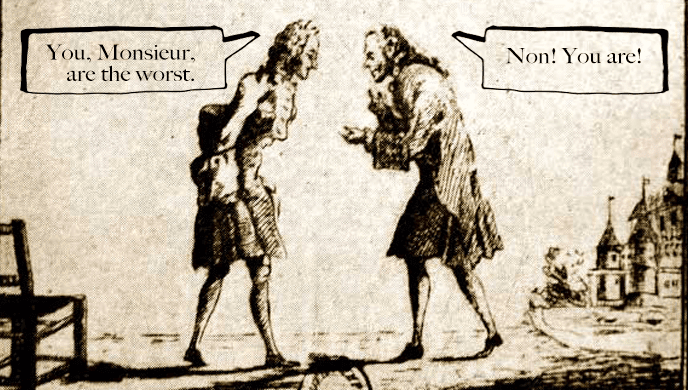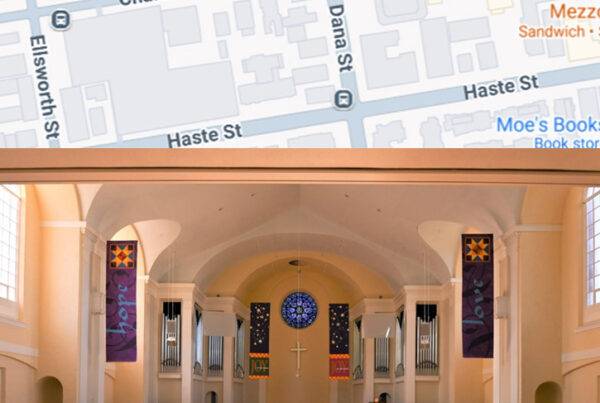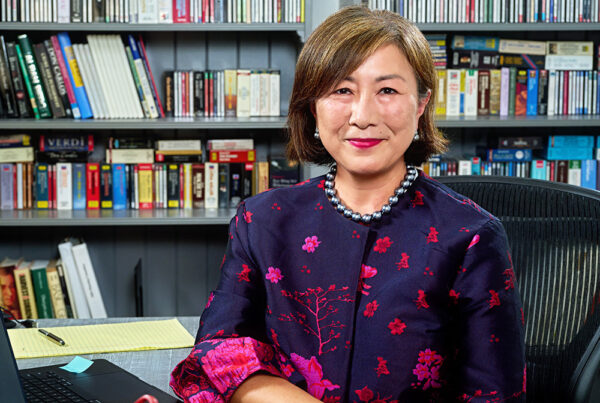RAMEAU & VOLTAIRE: A Brief History of Collaboration and Contention
(Part 1 of 2)
Bruce Lamott
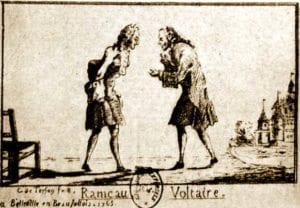
Rameau and Voltaire
“Rameau’s misfortune is to be a blockhead advised by self-styled connoisseurs. This is the reason why he has never written and will never write a good opera.” So wrote Voltaire in a letter to his niece, Madame Denis, just months before the Duke de Richelieu, master of the King’s bedchamber, yoked Rameau and Voltaire together for the command performance that was to become Le Temple de la Gloire. The two pugnacious geniuses had already collaborated (and contended) for six years on Samson, an opera that ultimately received the coup de grâce from royal censors who claimed that their treatment of a Biblical subject was blasphemous.
In the course of this doomed effort, the considerable correspondence between author and composer shows Voltaire to be surprisingly insecure. “I feel that I have no talent whatsoever for lyrics. It is a special kind of harmony that I fear I have not been able to grasp,” he writes. At the same time, however, he has the temerity to advise Rameau on musical matters, especially recitative: “I want Samson to be in the new style: only one scene of recitative in each act…Are you not weary of the uniform melody, of the perpetual eus which end our feminine syllables with the monotony of an antiphonary?” The battle lines were already being drawn that would shortly result in the “War of the Comedians” (Querelle des Buffons) in 1752-54 between the proponents of the Italian and French styles of comic opera, and Voltaire is already taking sides: “M. Rameau may take my word that his success will be great if he adds to his lovely music a few arias in mitigated Italian style.”

La Princesse de Navarre in the Grande Ecurie
By the time Voltaire and Rameau were compelled by Richelieu to produce a comedy-ballet for the Dauphin’s wedding in 1745, each man was beset with “advisors” hostile to the other. La Princesse de Navarre was created with the pressure of an eight-month deadline that exhausted both of them, and Rameau’s requests for revisions and rewrites exasperated Voltaire. Freely pronouncing Rameau insane, he writes: “But do try to have Madame de Tencin write to the Duke de Richelieu that Rameau ought to be bled white and thrown into the bouillon pot.”
Performed on February 25, 1745, in a voluminous theatre created out of the riding school, the Grande Écurie, La Princesse de Navarre was, according to Voltaire, “acceptably good; it was favorably received although it was not flattering.” In short order, he received a royal commission, a title, a generous pension, and, ultimately, a membership in the French Academy. Rameau received only a small commission, but Voltaire generously directed that all of the proceeds from their works should go to him.
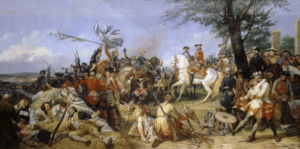
The Battle of Fontenoy
On May 11, Louis XV witnessed the French defeat of the Pragmatic Allies–a coalition Dutch, British, and Hanoverian troops– in a major battle of the War of the Austrian Succession, the Battle of Fontenoy. He returned to Versailles as a conquering hero, heralded by Voltaire responded in a sycophantic poem, The Battle of Fontenoy.
The Monarch is a man, and the Victor is a father;
He goes so far as to deign to comfort his enemies…
And from the Elbe to the Seine everywhere we hear:
The most Cherished of the Kings is also the Greatest.
When the Duke de Richelieu once more approached Voltaire and Rameau to provide an entertainment celebrating the King’s victory, the stage was set (literally) for an opéra-ballet, Le Temple de la Gloire, in the same theatre. The themes of the paternal monarch and magnanimous victor are seen in the final act (Trajan), though Voltaire’s cautionary tale also vividly illustrates the behaviors (envy, cruelty, debauchery) that will not meet the admissions requirements for the Temple. Rameau’s extravagant music as well as the dance and stagecraft swathe the moral lesson in a sumptuous presentation. While Voltaire’s status as a toady of the court was soon to fall, Rameau’s operas were to usher in a new era of musical and dramatic expression, and with Le Temple de la Gloire, their odd-couple collaboration was about to come to an end.
See Philharmonia’s first fully staged opera, Rameau’s Le Temple de la Gloire, April 28-30 at Zellerbach Hall.

